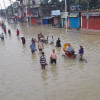Don't turn receivers of aid into photo props

Ashari, a young mother of two, stands in queue for food relief assistance. The floods have rendered her, and others in her community, helpless. She has her face customarily hidden behind her saree, and approaches the relief provider with some trepidation.
The story that unfolds later is this: There are camerapersons everywhere and Ashari is overwhelmed by the many camera flashes on her face as she tries to hide behind her veil. When she is asked to show her face for a photo while taking the bag of food assistance, she feels thoroughly uncomfortable. Many have fallen prey to the unforgiving lens of the camera, and it is quite often that the lines between relief and respect becomes blurred. Sometimes, some people have to exchange their self-respect for a bag of rice and lentils.
Those who help to bring these people aid at the right time also face many challenges, such as time constraints, pressure to source large amounts of food and basic necessities, and crowd management. If one is to give them the benefit of the doubt, it may be prudent to say that it is only due to these reasons, and not for other selfish motives, that the quality of aid distribution suffers. However, if providers of aid were to dig deeper into their conscience, they may just find some room to improve themselves and their helpful endeavours.
Take, for example, the general make-up of society. There are a number of classifications in a community, such as elderly persons, the very young, women, the disabled, widows, single mothers, young women, etc. Each person belonging to these classifications comes with their own requirements and it is important to recognise them rather than discriminate against them. An old man should be able to cut the line and move ahead of the able-bodied. The child who has come on behalf of his/her mother should be allowed to receive food for their family. The disabled person should be served closer to their home. It all boils down to preserving dignity – one must be served as per one's needs, and not according to a standardised protocol.
To be honest, there isn't a lot that needs to be done to overcome these challenges. There are certain universal standards, such as the widely used Core Humanitarian Standard, which talks about nine points of basic humanitarian needs. Similarly, culturally, and locally, authorities are well aware of the basic requirements of the people in their communities. Making the simple effort to talk to the local authorities and research universally approved standards can help aid providers and first responders to design care packages that truly adhere to victims' requirements. This can also reduce the problem of overlapping, as most organisations only think of a few common items to give out.
From a humanitarian point-of-view, it is a given to ask people, and to ask in a manner that does not seem forceful, before taking their pictures and painting them as the wretched victims of a natural disaster, or as the ultra-poor looking for help. The people in need of aid will seldom be able to refuse those who are providing that coveted bag of food and necessities. However, no one wishes to have their pictures taken for such reasons. Unfortunately, this awareness often eludes the parties in-charge of distributing relief goods. If pictures must be taken for documentation purposes, it may be more considerate to take them from angles that do not compromise the receiver's dignity. The idea is much the same for interviews. Words should not be put in a disadvantaged person's mouth simply because it will gather more reads, views, or the sympathy of the masses.
Aid providers do more than simply distribute bags of food. They bring with them a sense of empathy and a feeling of oneness and support for the people whom they serve. However, the picture one sees when they see aid efforts are a little different from that description. Tossing food bags towards the needy or sitting inside a clean dinghy while victims come to receive their packages in waist-deep water are common scenes during organised aid efforts. The way in which help is provided is as important as the help itself. If the victim goes back home with a bag of food and their self-esteem in tatters, the aid in question does nothing for their mental wellbeing or for their hope of a more resilient future.
There are plenty of humanitarian organisations that continue to go forward to help people silently, without flaunting or abusing their advantaged positions, and keeping in mind the fundamental rights of the people, even in dire situations, simply to bring smiles on the faces of the suffering people.
The ongoing relief efforts are appreciated, and all these points of discussion are solely being put forth so that more such endeavours can flourish. They do not, in any way, mean to discount the general goodness of people or their inherent nature to help where help is needed.
Kazi Amdadul Hoque is senior director at Friendship and is working for strategic planning, climate action and development. Email: [email protected]

 For all latest news, follow The Daily Star's Google News channel.
For all latest news, follow The Daily Star's Google News channel. 








Comments